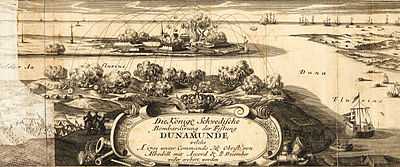Daugava (river)
| Daugava | |
|---|---|
| Other name | Western Dvina, Russian: Западная Двина (Západnaya Dviná), Belarusian: Заходняя Дзвіна ([zaˈxodnʲaja dzʲvʲiˈna]), German: Düna |
| Origin | Valdai Hills, Russia |
| Mouth | Gulf of Riga, Baltic Sea |
| Basin countries | Belarus, Latvia, Russia, Lithuania, Estonia |
| Length | 1,020 km (630 mi)[1] |
| Source elevation | 221 m (725 ft) |
| Mouth elevation | 0 m (0 ft) |
| Avg. discharge | 678 m3/s (23,900 cu ft/s) |
| Basin area | 87,900 km2 (33,900 sq mi)[1] |


The River Daugava or Western Dvina is a river rising in the Valdai Hills, Russia, flowing through Russia, Belarus, and Latvia, draining into the Gulf of Riga in Latvia, an arm of the Baltic Sea. The total length of the river is 1,020 km (630 mi):[1] 325 km (202 mi) in Russia, 338 km (210 mi) in Belarus,[1] and 352 km (219 mi) in Latvia.[2] It became connected to the Berezina and Dnieper rivers in the 19th century by a canal, which no longer functions. The Daugava forms part of the international border between Latvia and Belarus.
According to C.Michael Hogan, the Daugava river began experiencing environmental deterioration in the era of Soviet collective agriculture (producing considerable adverse water pollution runoff) and a wave of hydroelectric power projects.
There are three hydroelectric dams on the Daugava – Rīgas HES just upstream from Riga or 35 km (22 mi) from the mouth of the river, Ķegums HPP another 35 km (22 mi) further up or 70 km (43 mi) from the mouth, and Pļaviņas HPP another 37 km (23 mi) upstream or 107 km (66 mi) from the mouth. A fourth one, Daugavpils HES, has been planned but has faced strong opposition. Belarus plans to build several hydroelectric dams on the Belarusian part of Western Dvina.
Geography
The total catchment area of the river is 87,900 km2 (33,900 sq mi), 33,150 km2 (12,800 sq mi) of which are within Belarus.[1]
Etymology
The Latvian name for the river, "Daugava" originated from the ancient Baltic words for "the great water" (daudz ūdens). The names for the Daugava in other languages; Dyna – Düna – Двина – Дзьвіна – Dźwina – Dvina - Väina have an unclear origin. This name is mentioned in the Viking sagas and the Chronicle of Nestor. According to the Max Vasmer's Etymological Dictionary, the toponym Dvina clearly cannot stem from a Uralic language, and it possibly comes from Indo-European word which used to mean river or stream.[3]
Cities, towns and settlements
Russia
Andreapol, Zapadnaya Dvina and Velizh.
Belarus
Ruba, Vitsebsk, Beshankovichy, Polatsk with Boris stones strewn in the vicinity, Navapolatsk, Dzisna, Verkhnedvinsk, and Druya.
Latvia
Krāslava, Daugavpils, Līvāni, Jēkabpils, Pļaviņas, Aizkraukle, Jaunjelgava, Lielvārde, Kegums, Ogre, Ikšķile, Salaspils and Riga.
Crossings
Belarus
Kirov Bridge, Vitebsk.
Latvia
Southern Bridge, Island Bridge, Railway Bridge, Stone Bridge and Shroud Bridge, Riga.
Dams of Rīgas HES, Ķegums HPP and Pļaviņas HPP
Vienības tilts, Daugavpils
Main tributaries
References
- ↑ 1.0 1.1 1.2 1.3 1.4 "Main Geographic Characteristics of the Republic of Belarus. Main characteristics of the largest rivers of Belarus". Land of Ancestors. Data of the Ministry of Natural Resources and Environmental Protection of the Republic of Belarus. 2011. Retrieved 27 September 2013.
- ↑ Latvian Encyclopedia 2. Riga: Valērija Belokoņa izdevniecība. 2003. p. 137. ISBN 9984-9482-2-6.
- ↑ Фасмер, Макс. Этимологический словарь Фасмера (in Russian). p. 161.
Further reading
- C.Michael Hogan. 2012. Daugava River. Encyclopedia of Earth. Eds. P.Saundry & C.J.Cleveland. National Council for Science and the Environment. Washington DC
Coordinates: 57°3′42″N 24°1′50″E / 57.06167°N 24.03056°E
| Wikimedia Commons has media related to Daugava. |
| ||||||||||||||||||||||||||||||||||||
